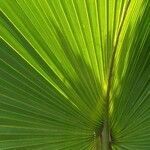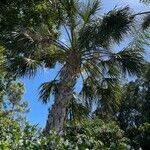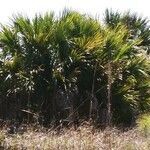A fan palm. The trunk is 15-20 m tall and 35 cm across. The leaves form a round crown. The leaf stalk extends into the leaf blade. The leaf stalk is 1-1.5 m long. The leaves are blue-green. The leaf segments are joined for about 1/3 of their length. The tip is strongly notched. The flowering stalk is about as long as the leaves. It is branched. The flowers are white to cream. The fruit are small and round and black when ripe. They are 8-14 mm across. They are edible.




